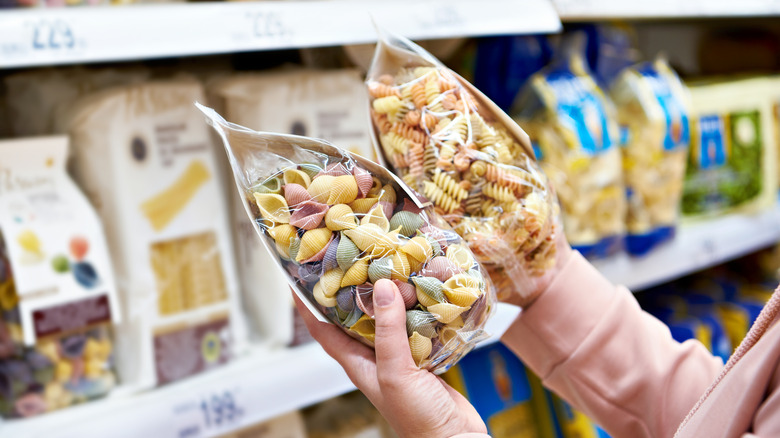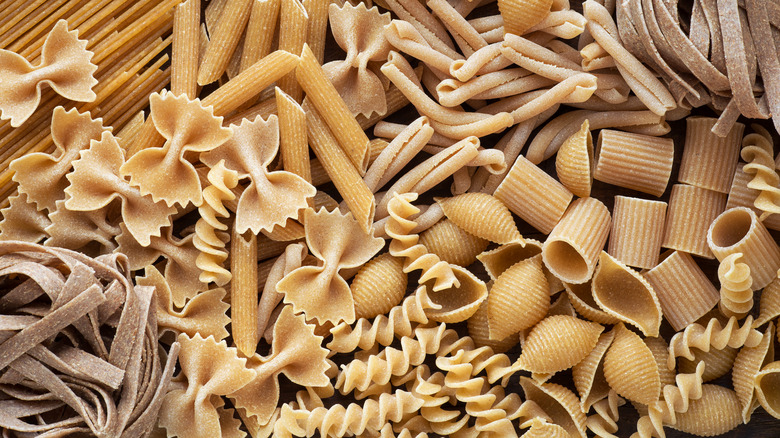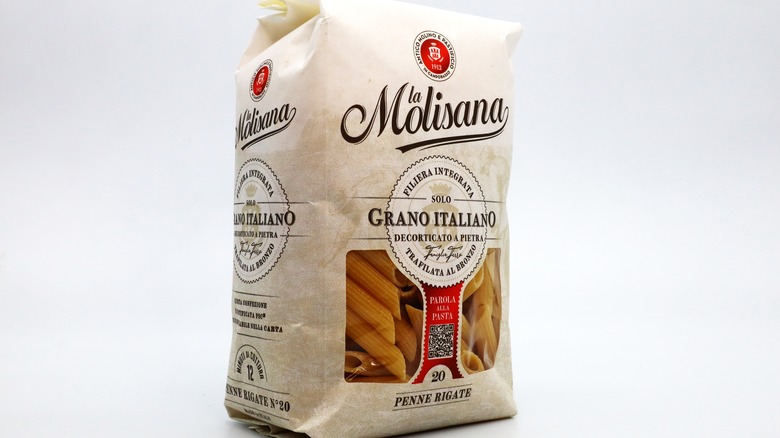How To Pick Out The Best Dried Pasta At The Grocery Store
Making pasta from scratch can be intimidating, but the good news is, you don't need to do all that extra work to eat delicious Italian food. You can find good-quality dried pasta at the grocery store — as long as you know what to look for.
First things first: Avoid products that don't let you peek into their contents. Visual inspection is crucial in selecting dried pasta, and one of the things you must look at is its color. Go for those that are opaque and pale yellow since this is an indication that the product was dried slowly over low temperatures — somewhere between 175 and 195 degrees Fahrenheit.
Manufacturers dry the extruded pasta pieces, so their moisture content goes from 31% down to 12 to 13%, making them stable and impervious to spoiling during storage. However, the danger with treating pasta at high temperatures for a quicker process is that its outer surface dries much faster than its inner one. With an uneven internal moisture content, the product cracks more easily during storage. Quick drying can also burn the starch content in its dough and lend it a golden-yellow hue, plus a bitter taste.
In comparison, slow drying allows the cut pasta pieces to remain relaxed, thus preserving their integrity. As a result, they cook faster and absorb water more evenly, creating that desirable al dente texture. Drying pasta slowly also creates minimal alteration to the dough's gluten, making it easier for the digestive system to break it down.
Texture is also an indication of its quality
Another thing to look at is the dried pasta's texture. A product that presents a rough surface is a good pick because this indicates its porosity. Porous dried pasta makes for a good dish, with the noodles able to catch and hold on to the sauce for a better pasta-to-sauce ratio and, consequently, better flavor distribution.
Check the label, too, if it discloses that the product is bronze-cut pasta. This means the manufacturer extruded the dough using a cutter that's cast in bronze rather than Teflon or aluminum. The metal's grittier texture leaves coarse imprints on the surface, leaving an uneven and porous texture. Meanwhile, products drawn through a Teflon-cast cutter take on a smoother, glossier appearance.
Both the slow-drying and bronze-drawing methods are traditional pasta-making techniques that take more time and have a lower yield. They also result in pasta that has an imperfect, artisanal look to it rather than an immaculate, plastic-like appearance. With both methods recognized as the standards in the pasta-making industry, products that went through these processes will often have 'slow dried' and 'bronze cut' stamped on their packaging. You can expect to pay more for them, but the payoff is you can anticipate enjoying an al dente dish later.
Choose brands that are transparent with their manufacturing processes
In 1967, Italy passed a pasta purity law to regulate production in the country. It decrees that dried pasta intended for domestic consumption must be made only with durum wheat. As such, the origin of the wheat used must be disclosed on the packaging. This emphasis on transparency has contributed to Italy's long-held position as an authority on and producer of quality pasta.
When buying dried pasta, whether from an artisanal brand or something more commercially popular and available, apply a similar principle of transparency. Look for a product that discloses where it was made and where it sources its ingredients. Pasta that's made in Gragnano, Italy is guaranteed to be of quality since the municipality is known for adhering to strict pasta-making criteria.
Similarly, quality pasta will have a short list of ingredients, citing no more than water and durum wheat or 'durum wheat semolina flour.' Durum wheat is a high-protein and high-gluten wheat variety while semolina is simply the by-product of milled durum wheat. Semolina has a coarse texture that feels more like sand rather than flour, and its high gluten helps pasta retain its shape and bite when cooked.
The easiest way to find quality dried pasta is to try what the experts recommend. Take Giada de Laurentiis' word and buy her favorite kind of dried pasta – Setaro – or be on the lookout for Ina Garten's go-to store-bought brands like De Cecco or Cipriani.



